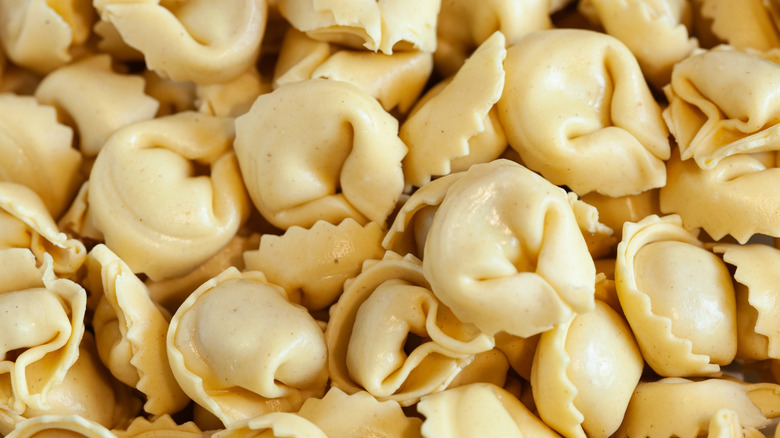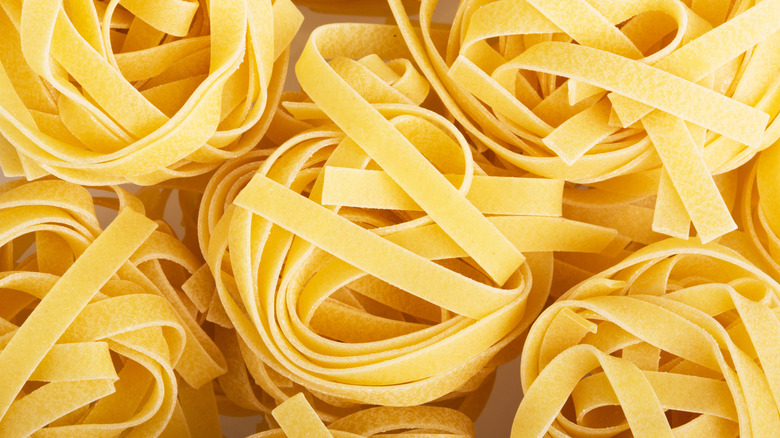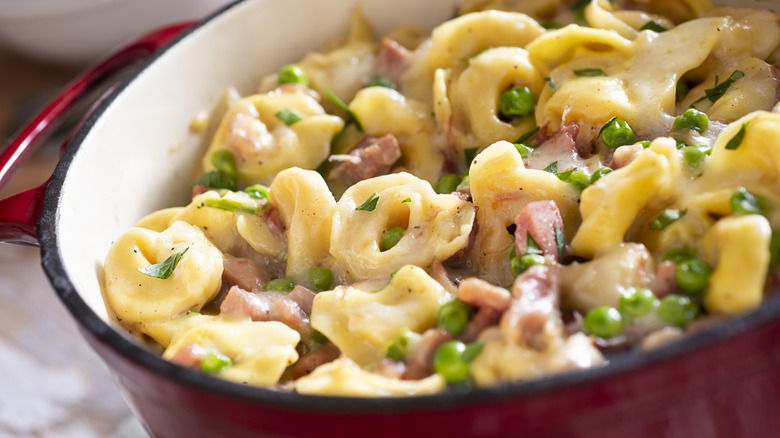The Color Of Your Store-Bought Tortellini Matters. Here's Why
When you want a quick, easy meal for the evening, but still want ito feel like you cooked and didn't just get fast food, tortellini is a great solution. A pack of pasta to warm through in one pan while a tub of creamy pasta sauce heats in another — it's perfect busy weeknight food. But there's a moment in that process that can cause a problem: picking the right tortellini at the grocery store. Pasta is one of those culinary items that seems extremely simple on paper. But when it comes to the difference between good and great, there's a whole world of science that many of us don't understand. This makes it difficult to know you're picking the right pasta without tasting it first.
It might seem like the easiest way to combat this pasta purchasing problem is simply to buy the most expensive and recognizable brand you can find, and just assume that it is good because it's fancy. However, that's a loss for the budget-conscious if you actually want to get the best product. Fortunately, there are some tricks to make sure you're getting the best tortellini at the grocery store — and a big one comes down to the color of the pasta. When you're shopping for tortellini you want to avoid pasta that has a dark yellow, orange, or even bronzy color to it. This color is actually a bad sign. Instead, you should be looking for tortellini where the pasta is a much paler yellow or more of an ivory color.
What the color of tortellini tells you
When you're browsing brands of tortellini at the grocery store, you can't see the insides and all you can go on is the outside of the pasta. It might seem reasonable to assume that darker, richer colored pasta is better quality. That sort of rule often holds true and it makes sense that the poorer quality pasta would be the stuff that looks more anemic. However, most of the time when it comes to pasta — including tortellini — that isn't the case.
So, though counterintuitive, it's better to avoid yellow, orange, and bronzy looking pasta in favor of pale, ivory colored pasta. That is the true sign of good quality pasta, and if you go shopping in Italy, you will actually struggle to find pasta that is yellow at all. Pasta is a simple combination of ingredients and none of them should be giving a bronzy look if those ingredients have been prepared well.
Why paler pasta is better
It might feel illogical to go for pasta that has less color, but there's good reasoning behind it all. There are two things that play into the color of pasta in the grocery store whether it's dried or used in fresh tortellini. One of these comes down to the ingredients. If different flours or preservatives and stabilizers are used, the color of the pasta can come out darker. While that's not always a bad thing, keeping your pasta simpler is for the best.
The more important issue that contributes to the color of store-bought pasta involves how the pasta was dried. For the best quality pasta, it should be dried very slowly at a relatively low temperature. The process should take days but can even take weeks. This helps to preserve the nutrients in the pasta. Of course, when it comes to mass production, time is money, and companies might use higher temperatures and much shorter drying times to get pasta to market. These higher temperatures can burn the starches and the sugars in the pasta, resulting in a sweeter taste due to caramelization followed by a bitter aftertaste from the burning.
Other things to look for when buying pasta
If you're still not sure which pasta to buy based on the color alone, there are two more things that you can look for to make sure you're getting a good product. The first is the texture of the pasta. Ideally, pasta that has been extruded or shaped should have a slightly rough texture from the friction of the process. The slight roughness of the pasta will help it to hold a good homemade-tasting store-bought pasta sauce and impart more flavor to the dish.
The other thing to look at is the ingredients list. The best pasta is usually made from durum flour and should have very little else. You can make homemade pasta with just flour, water, and eggs. While there might be some additional flavors, any other ingredients suggest that the pasta isn't as fresh or isn't made as well. When it comes to pasta, the best result comes from a simple method done well.



